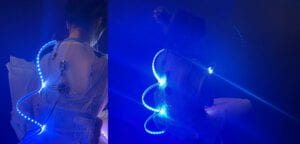
Team Members:
Chanel & Luna
Description & Concept:
The body has been long seen as a void and a passive medium on which cultures are implanted. In both Sartre’s and Beauvoir’s work, “the body” is figured as a mute facticity, anticipating some meaning that can be attributed only by a transcendent consciousness. In other words, the body itself signifies nothing. What if the body is never prior to significance? It is constantly responding to the outside world, and interacting with it, too. It expresses feelings actively in a way that is neither visible nor hearable, and thus it is oftentimes neglected as if it has always been a white canvas on which things happen. The piece hopes to convey the idea that the body is never a void, but rather an active subject. It lights up and sings along with the movements of the hands.
Research & Development:
- Main Idea:
- The body is actively responding to the environment, but it doesn’t speak for itself. The project helps the body show colors and sing out its feelings.
- Inspirations:
- Plant Communication:🌱
One of the inspirations for our work comes from watching the Plant Talk video in our Week 3 assignment. Plants emit sounds when they lack water, albeit very faint, requiring special equipment to be heard. Similarly, the human body constantly interacts with the external environment, responding to stimuli, although it doesn’t speak for itself. Therefore, one of our inspirations is to create clothing that allows our bodies to be heard. - We just want to make the body audible and interactive, haha!🎵
Both of us are very fond of things that can make sounds, and we want people with this new body to be able to play with their bodies as an instrument. We hope that sound can be produced from multiple parts of the body, with each part generating different interactions and, thus, different sounds through different movements. To highlight different parts, we feel the need to incorporate neopixels into our design. When sound is produced, the neopixels of that particular area will light up to signify which part has produced the sound.
- Plant Communication:🌱
- Materials:
- Fish Bone & Various White Clothes
- Equipment:
- Arduino, Processing, Lilypad, Velostat, and XBee
- Methodology & Sketch: (textile/circuit+coding)
- With our inspiration and the knowledge we have gained, we have embarked on the plan to construct the new body.
- In terms of coding and circuitry, our main principle follows Arduino sensing the values of velostats, transmitting them to neopixels within Arduino, while also sending them to processing to generate different sounds. We also utilized Xbee to make our device capable of wireless functionality.
- For the outfit design, we have chosen to use fishbones as a framework to build our entire body, dividing it into many sections. We intend to use different white textiles as the fabric for each section. We have three velostats planned to be placed respectively on our clavicle (neck), abdomen, and the upper side of the thighs, with their corresponding neopixels fixed onto the framework surrounding the body constructed by fishbones.
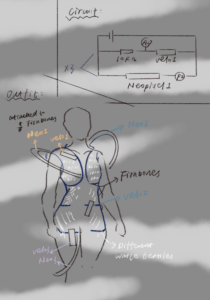
- Experiment 1 (Build Fishbones)
- Chanel and Luna are both novices in making clothes. We bought fishbones, but we were worried that we wouldn’t know how to assemble them. Most tutorials online teach how to sew fishbones together using a sewing machine, but neither of us knows how to use one. So Luna searched for “how to make a suit” and came across the following image, realizing that we could use the lines on it to structure the fishbones.
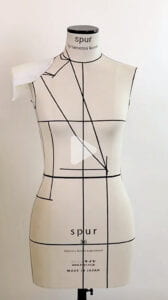
- Chanel suggested using hot glue to stick multiple fishbones together at the joints. So we brought in a human-shaped mannequin, figured out where to build the fishbones (as shown in the figure below ), and began constructing them on it. (Haha! We realized we didn’t even take a picture of us building the fishbones because we were so busy and forgot…)
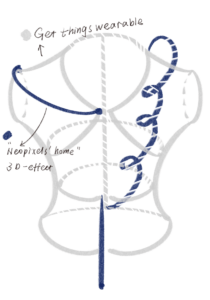
- By now, we had turned it into a garment that could be worn on a person by using fishbones. Later, when fixing the neopixels to the clothing, we still used three fishbones to secure them at several nodes where the fishbones connect, creating a 3D wrap-around effect.
- Chanel and Luna are both novices in making clothes. We bought fishbones, but we were worried that we wouldn’t know how to assemble them. Most tutorials online teach how to sew fishbones together using a sewing machine, but neither of us knows how to use one. So Luna searched for “how to make a suit” and came across the following image, realizing that we could use the lines on it to structure the fishbones.
- Experiment 2 (Making Different white textiles)
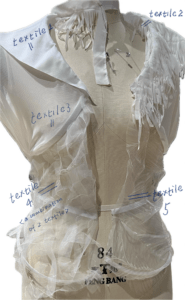
- The overarching design concept behind our use of white fabrics is to convey a sense of being easily overlooked, lightweight, and responsive to the external environment, much like a blank sheet of paper. By employing various white materials, we aim to highlight the complexity of our body as well.
-
- Textile 1: Solid White fabric
- As for one side of the collar, there’s nothing particularly special about it, making it easy to overlook. However, below, from our collarbone to the shoulder, lies a position that people unconsciously touch in their daily lives. Here, we’ll place a velostat.
- Textile 2: White fabric with long “fur”
- On the other side of the collar, there are numerous long strips of fur. When the wearer moves, these fur pieces sway, visualizing our body’s response to the external environment. Additionally, this textile was later also used as a decoration covering another velostat, which should have been placed on the upper side of the thighs.
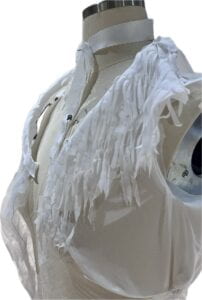
-
- Textile 3: Semi-transparent frosted white fabric
- We have used this type of textile on both the chest and upper back. It is semi-transparent (but not as transparent as other materials), giving a soft and delicate feel, so we decided to use this material on the chest. Additionally, this textile was later also used as a decoration covering another velostat, which should have been placed on the abdomen.
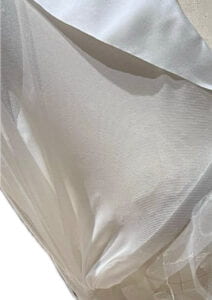
-
- Textile 4: White fabric with sparkles and silk-like translucent white fabric
- This piece of fabric took us the longest time because we first needed to cut two different materials into long strips and then weave them together following the method we used to weave apple and banana peels in our Week 5 assignment. However, these two types of fabric were prone to sticking to other fabrics—one was slippery, and the other was more furry—so both cutting and weaving took us some time. After weaving, we sewed threads along the edges to secure this piece of fabric and then attached it to the fishbones.
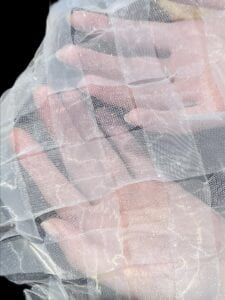
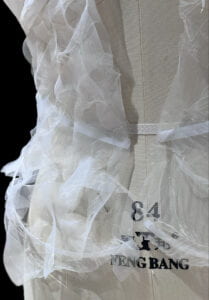
- Textile 5: Translucent rippled silk-like white fabric
- This piece of fabric was attached to the other side of the front of the body as well as the lower back. One reason is that we were too lazy to make a second piece of fabric similar to Textile 4. The second reason is that we really liked the texture of its lines, which resembled various textures and nerves within the human body. (The second reason seems like an excuse for the first one, haha!)
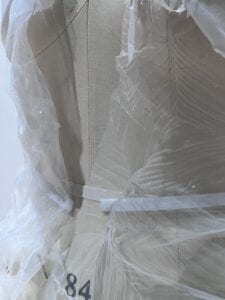
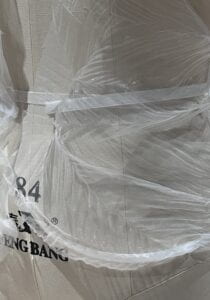
- Experiment 3: Coding
- Arduino
- We used the code from Week 3 Exercise 1: Lilypad regarding neopixels and modified it because we used three neopixels and needed to send values from three velostats to processing. Arduino Code
- Processing:
- Under the introduction of our friend Freddie, we utilized the sine wave from the Processing library as a foundation for modification. Additionally, we referred to the code from Interlab, which facilitates the transmission of data from Arduino to Processing, enabling the values from our velostats to be transmitted to Processing. We mapped these three values as variables to be associated with the frequency and amplitude of the sound. Professor Gohi also helped us with the port problem. (By now our coding can run and utilize the sound and neopixels!) We were very excited when we achieved this on Monday’s midnight! Yet, everything changed when we met Xbee the next day😇😇 Processing Code
- Xbee
- We needed Xbee to make our work wireless (without having to be constantly connected to the computer to receive the values from Processing). Chanel and Luna looked at the Xbee instructions in the IMA studio at 2 a.m. on Monday but still didn’t know what to do, so we decided to seek advice from Professor Marcela on Tuesday. She helped us utilize the Xbee software and did some coding. However, after installing Xbee, Processing was unable to receive values, and the port kept showing as busy or unavailable. Later, Professor Marcela helped us add a few lines of code to Arduino and reorganize the code in Processing. Finally, our code started running with Xbee. (Thank you, Marcela!)

- Experiment4 (Alligator Clips)
- We used alligator clips to connect the circuits at first so that it was easy to test where things went wrong. Since we wanted the LED lights and the sound to be varied, we decided to use velostats to control the electric current and sew three of them over the weekend. The photo is a complete “alligator clips version” of our circuit:
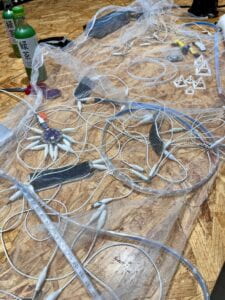
- We used alligator clips to connect the circuits at first so that it was easy to test where things went wrong. Since we wanted the LED lights and the sound to be varied, we decided to use velostats to control the electric current and sew three of them over the weekend. The photo is a complete “alligator clips version” of our circuit:
- Experiment5 (Soldering Wires)
- After succeeding in making things work using the alligator clips, we switched to soldering wires, which can be cut into different lengths and have better bendability, thus better for wearables. We replaced all the alligator clips with the wires and cut the length of some parts that did not need to be long (e.g., the wires between the resistors), and we measured the length from the lilypad to the three velostats that were supposed to be attached to certain parts of the body, like the collarbone and waist. With everything done, we connected one of the XBees with the Lilypad so that the whole piece could work without connecting to the laptop (using the XBee code mentioned above, with another XBee connected to the laptop to send signals). Finally, we connected a power bank to the Lilypad to power it up, and it could work wirelessly (though it was still with a lot of soldering wires, it did not need to be connected to the laptop to receive the code or gain power).
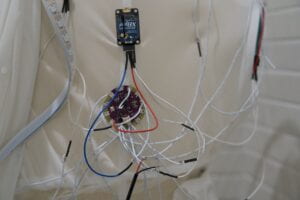
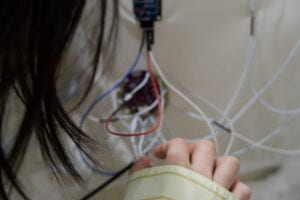
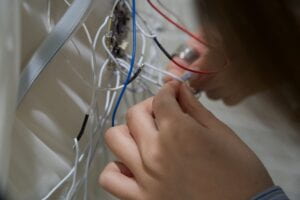
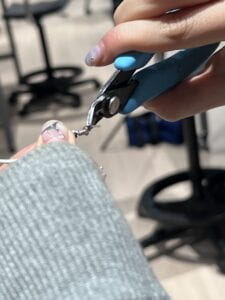
- After succeeding in making things work using the alligator clips, we switched to soldering wires, which can be cut into different lengths and have better bendability, thus better for wearables. We replaced all the alligator clips with the wires and cut the length of some parts that did not need to be long (e.g., the wires between the resistors), and we measured the length from the lilypad to the three velostats that were supposed to be attached to certain parts of the body, like the collarbone and waist. With everything done, we connected one of the XBees with the Lilypad so that the whole piece could work without connecting to the laptop (using the XBee code mentioned above, with another XBee connected to the laptop to send signals). Finally, we connected a power bank to the Lilypad to power it up, and it could work wirelessly (though it was still with a lot of soldering wires, it did not need to be connected to the laptop to receive the code or gain power).
- Each Team Member’s contribution
- We did most of the work together. From generating ideas to making clothes, from coding to building the circuit, from delight to despair, and from despair to delight (not so much delight😬)! Chanel sewed the three velostats herself at the weekend to save Luna’s life (since Luna was busy with other midterms by then. XOXO from Luna <3333) And of course, great thanks to our professor Marcela for helping us with Xbees and pointing out the right direction for us!😚And thanks, Gohai! Andy and Freddie for helping us with the code🪄
Finished Work:
Model: Sophia Wan
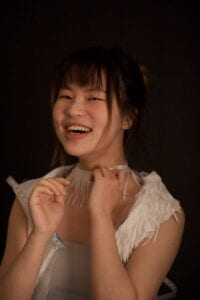
Photos:
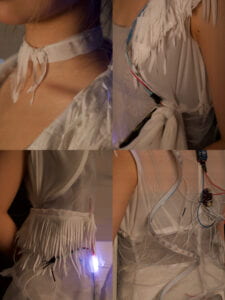
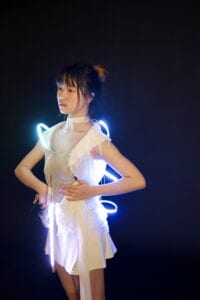
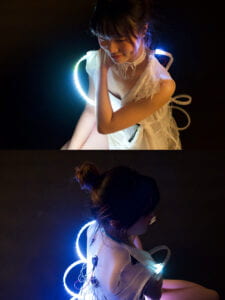
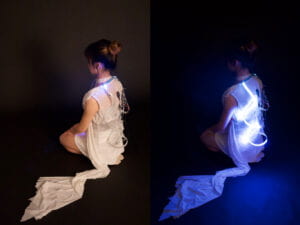
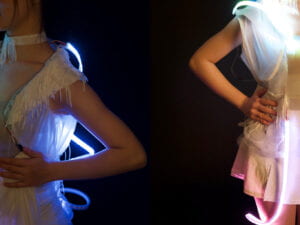
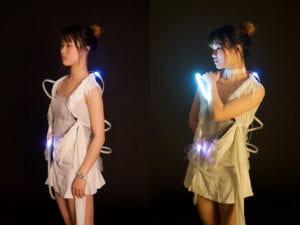
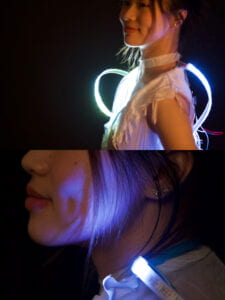
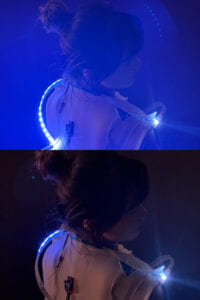
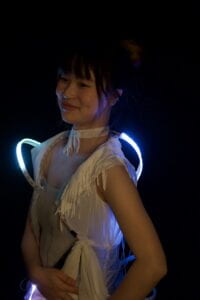
Video:
Behind Scene:
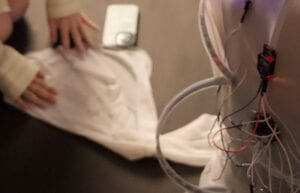
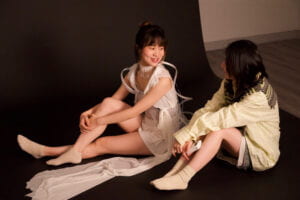
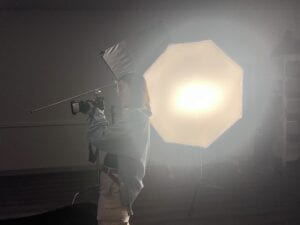
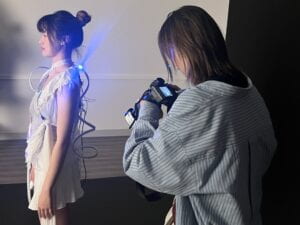
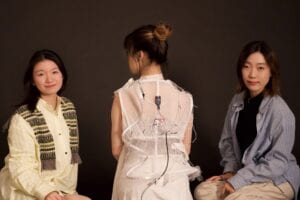
Luna’s Conclusion:
I feel like we’ve spent a lot of time on this project, but the results are not quite satisfactory. We’ve had breakdowns on many late nights, questioning whether what we’ve created is truly a body. Is it new enough? Our initial goal was to create a body that could be heard, generating various sounds and lights as people touched it for self-expression. Have we achieved that? I think I can give a positive answer. But the effect is not up to our expectations, because several things went wrong:
1) Velostat Placement: The positions we initially set were the clavicle, abdomen, and upper thigh. However, during the actual installation of the wires, due to inaccuracies in length, these positions deviated, making it seem like we randomly chose places for touching. Moreover, we didn’t even consider the heart, such a crucial and emotive area (a feeling that wrapped us during this project).
2) Insufficiently Innovative Materials: This was a headache and a regretful aspect during the production process. We chose various white fabrics, but they were just fabrics, very traditional and conventional. This resulted in our work resembling more of a white garment than a new body. If we replaced the white fabrics with abstract shapes representing various parts of the body printed in 3D, I think it would make our intentions clearer to the audience. Despite spending a long time selecting and constructing textiles, feedback from professors and classmates suggests that we spent a lot of time but didn’t achieve much. On the day of the presentation, we shouldn’t have worn a white undershirt that made it difficult for people to see the textiles of our clothes clearly.
3) Inadequate Concealment of Wires: Despite them being white, the wires still appear somewhat messy and unsightly from behind. Our initial idea was to use conductive silver wires from Week 1 to connect various components, sewing them into the clothing. However, time constraints made it impossible for us to accomplish this.
There’s nothing particularly prideful about this work for me. What I feel most proud of is that we completed the task in a very short time frame—”completion is more important than perfection,” as they say. Chanel is always a great partner, and despite both of us feeling overwhelmed during our group work, we remained harmonious and productive. I feel guilty about something I couldn’t change, which is that during the week between announcing our project and needing to present, I had many midterm deadlines. I felt like my brain cells didn’t support me in coming up with better ideas, and my thoughts couldn’t fully focus on this assignment. We mostly started working as soon as we had ideas. Although this is a personal conclusion, both Chanel and I felt a bit frustrated on the day of the presentation. She quoted something her high school language arts teacher said, “Direction is more important than effort.” I’d like to echo that sentiment here. We’re both looking forward to the final project, hoping to learn from this experience, armed with knowledge from the second half of the semester, so we can start thinking and creating something new and cool earlier.
Hi Luna, we didn’t mean you worked too much and didn’t achieve that much. I wanted to say that you spent most of the time with the electronics, and didn’t have so much time to work on the design of the wearable. But that’s not something bad.
I also said this to Chanel:
I think you should continue with this idea and develop more the wearable design and the kinetic part, but the sound it’s really nice and original in your project.